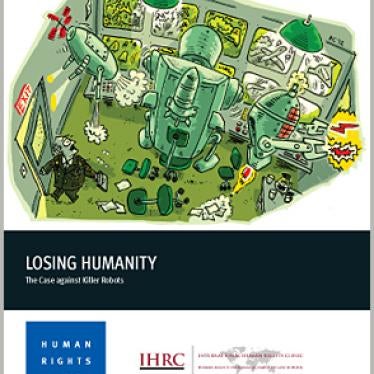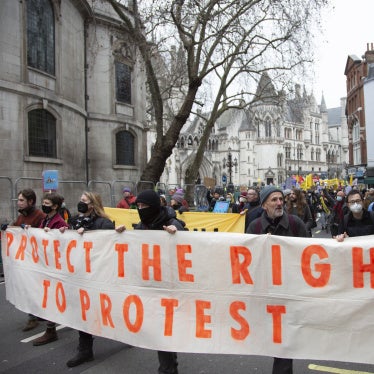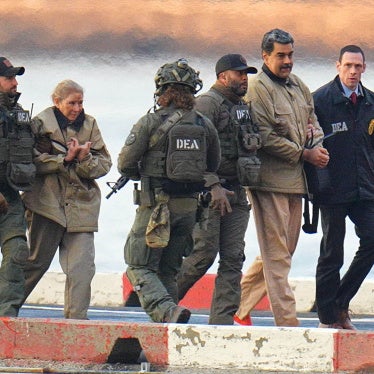As told by Bonnie Docherty, senior researcher, Arms Division:
In the dusty Afghan village of Ishaq Suleiman, a small boy, about 4 or 5 years old, handed me a piece of a cluster munition that he clearly used as a toy. His plaything was a small black cap called a spider, and thankfully not dangerous, unlike other parts of the weapon.
It was 2002, and I had come to Afghanistan to research why so many Afghan civilians died from US cluster munition attacks, and how we could prevent more deaths. Cluster munitions open in the air, releasing scores of explosive submunitions (also called bomblets) over an area the size of a sports field. Many of the bomblets don’t detonate upon impact, but may explode days or even years later, if picked up by a playing child or disturbed by a farmer’s plow. The US, in its air campaign against the Taliban, had targeted parts of Afghanistan with cluster bombs.
My team and I traveled to the village, near Herat, after hearing reports of a bombing. Witnesses told us munitions had exploded over the village and nearby fields, but we didn’t find much physical evidence on the ground. We asked the villagers if they had seen anything, and about 20 or 30 people, including the young boy, crowded around us, bringing bomb pieces they had gathered. The pieces ranged from 5-foot-long cluster munition canisters to small metal fragments from the bomblets. Fortunately these particular scraps were not dangerous, but we warned the people not to collect them in the future – handling pieces of these weapons can be deadly.
Seeing bomblets on the ground in Afghanistan illuminated for me how they worked and the danger they posed to civilians. I saw how the explosive remnants hid in fields and hung in trees. Seeing the bright yellow metal and intriguing shapes also made me understand why kids wanted to pick them up. In short, I got a better sense of the problem.
Over the next seven years, I researched cluster munition attacks in Iraq, Lebanon, Israel, and Georgia. Each investigation bolstered my conviction that these weapons were unacceptably dangerous to civilians.
To stop their use, Human Rights Watch co-founded the Cluster Munition Coalition, and we ultimately became a driving force behind the treaty to ban the weapons. Our painstaking research helped convince countries to sign on, and on August 1, 2010, the treaty went into effect. That night, I watched the countdown clock on the coalition’s website tick to midnight. Use of cluster munitions is now illegal for all 111 countries that have joined the treaty.
Military issues and the effects of war on society always fascinated me – because war changes the course of history, and compelling human stories emerge. Before joining Human Rights Watch I worked as a journalist for a suburban Boston newspaper, and I managed to convince both the Pentagon and my editor to send me to postwar Bosnia in 1998, where I embedded with US peacekeepers for a week. I knew I wanted my work to help improve people’s lives around the globe, which led me to study human rights and international humanitarian law in law school.
After graduation, I joined Human Rights Watch. My first day in the office was to be Sept. 12, 2001, but the terrorist attacks left me – and the United States – at a standstill. The Arms Division, where I had been assigned, scrapped my initial assignment. Six months later, after the US began its campaign to oust the Taliban, I found myself in Afghanistan, researching cluster munitions.
Now, Human Rights Watch has turned its attention to “killer robots” – machines that could identify targets on the battlefield and kill them with no human intervention. While today’s drone responds to a person’s command, these fully autonomous weapons would not have people behind the controls. Although such robots do not yet exist, experts believe they could be developed in 20 or 30 years, if not sooner.
The main problem with these robots is that they would lack human qualities necessary to protect civilians. They wouldn’t have the human judgment to tell the difference between a soldier and a civilian in a war zone. They would also have no concept of mercy. History is replete with stories of heroes saving others during wartime, combatants allowing villagers to flee to safety, and soldiers only pretending to shoot their guns, as they didn’t want to kill people. People will act on the human connection they feel with each other, even in the midst of the nightmare that is war.
Human Rights Watch wants to ban these weapons before they’re even developed – we want to protect civilians from this threat.
I remember the day the convention banning cluster munitions was adopted. It was the highlight of my career – and one of the biggest days of my life. Hopefully we will have similar success prohibiting killer robots, but this time pre-empt the civilian suffering before it even begins.







